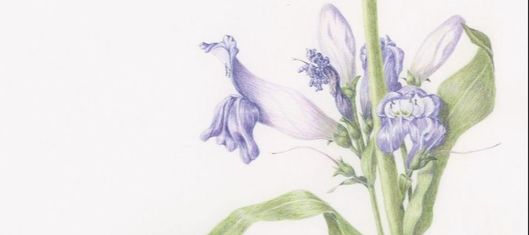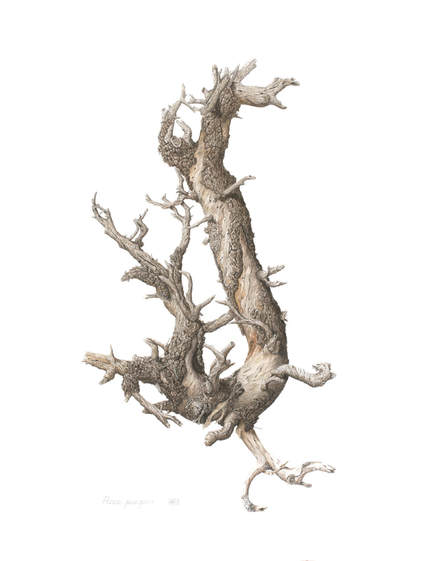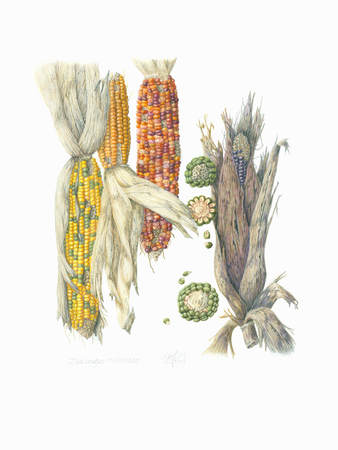
Zea mays indurata
20" H X 16" W prints available
colored pencil
"Indian corn" is often a subject for botanical art. I chose a life-sized composition made from cobs I got from a neighborhood farm to show the wide variety of colors possible.
20" H X 16" W prints available
colored pencil
"Indian corn" is often a subject for botanical art. I chose a life-sized composition made from cobs I got from a neighborhood farm to show the wide variety of colors possible.
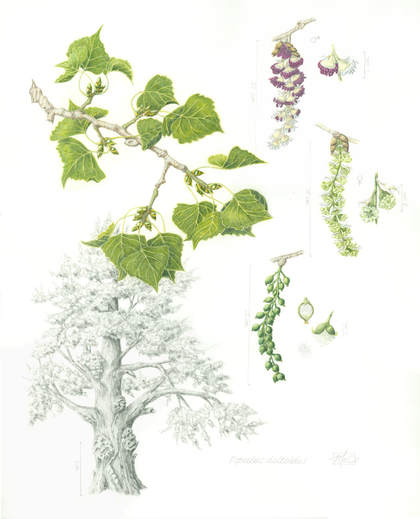
Populus delotides
20" H X 16" W prints available
mixed media, colored pencil and graphite
Cottonwood trees are abundant in Colorado. My town has many that are over 150 years old and 40 feet tall. The particular tree shown here grows along a farm field and has many large burls likely from injury from farm equipment. The trunk is approximately 4 feet in diameter. I started the piece to show off the gnarled tree trunk, but soon became fascinated with the intricate male and female flowers.
20" H X 16" W prints available
mixed media, colored pencil and graphite
Cottonwood trees are abundant in Colorado. My town has many that are over 150 years old and 40 feet tall. The particular tree shown here grows along a farm field and has many large burls likely from injury from farm equipment. The trunk is approximately 4 feet in diameter. I started the piece to show off the gnarled tree trunk, but soon became fascinated with the intricate male and female flowers.
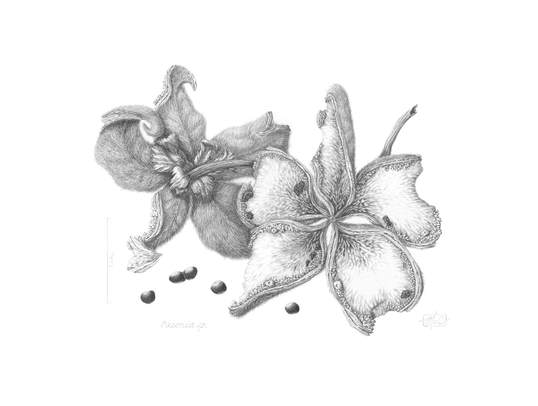
Peonia sp.
16" H X 20" W prints available
graphite and carbon dust
These peony seed cases are dried specimens with an amazing variety of textures from the silky insides to bristled outer layers. The black peony seeds mimic black pearls.
16" H X 20" W prints available
graphite and carbon dust
These peony seed cases are dried specimens with an amazing variety of textures from the silky insides to bristled outer layers. The black peony seeds mimic black pearls.
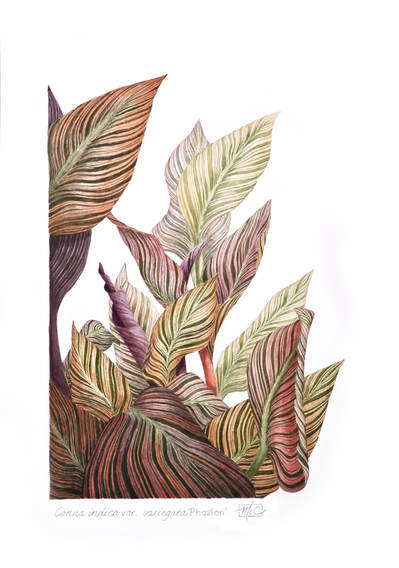
Canna Contours
20" H X 16" W prints available
watercolor
These variegated canna grow in a neighbor's garden, very near a large lake. I chose to show them back-lit by the bright reflected sunlight coming from the lake. This specimen was done in early summer before flower buds appear, but while the curled leaves are still unfolding.
20" H X 16" W prints available
watercolor
These variegated canna grow in a neighbor's garden, very near a large lake. I chose to show them back-lit by the bright reflected sunlight coming from the lake. This specimen was done in early summer before flower buds appear, but while the curled leaves are still unfolding.
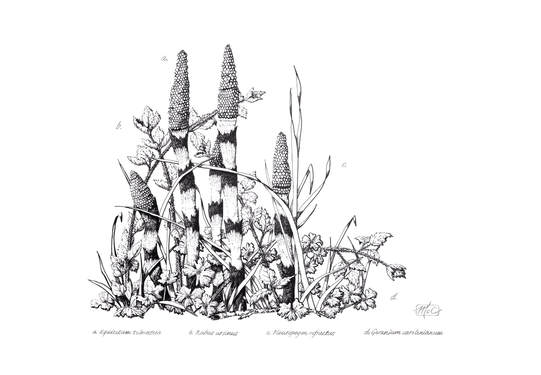
Along the Oregon Coast
16" H X 20" W available
Pen and ink on Mylar
This composition is a small sample of the varied plants that grow just beyond the high tide of the Oregon coast. The large species horsetails, blackberries, wild geranium, and grasses are considered to be invasive species but are nevertheless quite common.
16" H X 20" W available
Pen and ink on Mylar
This composition is a small sample of the varied plants that grow just beyond the high tide of the Oregon coast. The large species horsetails, blackberries, wild geranium, and grasses are considered to be invasive species but are nevertheless quite common.

Penstemon
11" H X 14" W available
colored pencil
Penstemon have a huge variety of colors and flower shapes. This one is common in Colorado gardens. It was also a good subject for a "reduced palette" technique. I created this illustration using only 2 greens, 2 violets, and a cream for highlight and indigo for shadows - just 6 pencils.
11" H X 14" W available
colored pencil
Penstemon have a huge variety of colors and flower shapes. This one is common in Colorado gardens. It was also a good subject for a "reduced palette" technique. I created this illustration using only 2 greens, 2 violets, and a cream for highlight and indigo for shadows - just 6 pencils.
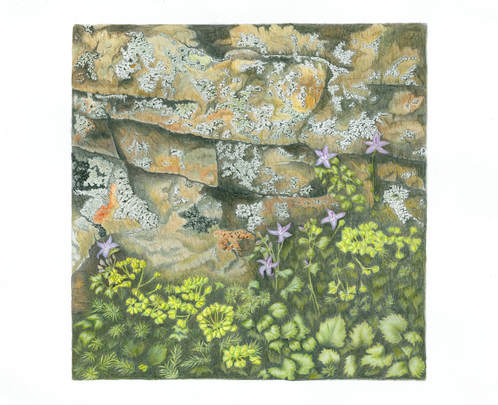
1 Square Foot
12" H X 12" W available
colored pencil on Mylar
It's hard NOT to find a square foot of planting at the Denver botanic Gardens that is a great composition. This square foot shows the native red rocks of Colorado, covered in lichen. The vinca flowers are struggling to survive amid several invasive species of ground cover plants. The day after I photographed and sketched this area for my illustration, the Gardens added an educational sign about the dangers of the invasives shown here.
12" H X 12" W available
colored pencil on Mylar
It's hard NOT to find a square foot of planting at the Denver botanic Gardens that is a great composition. This square foot shows the native red rocks of Colorado, covered in lichen. The vinca flowers are struggling to survive amid several invasive species of ground cover plants. The day after I photographed and sketched this area for my illustration, the Gardens added an educational sign about the dangers of the invasives shown here.
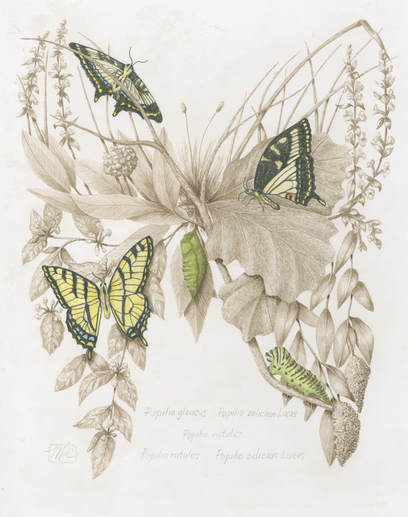
Swallowtail
14" H X 11" W available
pen and ink, colored pencil on watercolor board
This piece is part of the "Drawn on Tradition" series taught at the School of Botanical Art and Illustration at the Denver Botanic Gardens. This time the art of butterfly illustrator and print maker, William H. Lizars (1788-1859) was the focus. His work features pen and ink backgrounds with watercolor insects. I chose a sepia ink to display the many plants Swallowtail butterflies feed upon. The 3 species of swallowtails shown here are done in colored pencil.
14" H X 11" W available
pen and ink, colored pencil on watercolor board
This piece is part of the "Drawn on Tradition" series taught at the School of Botanical Art and Illustration at the Denver Botanic Gardens. This time the art of butterfly illustrator and print maker, William H. Lizars (1788-1859) was the focus. His work features pen and ink backgrounds with watercolor insects. I chose a sepia ink to display the many plants Swallowtail butterflies feed upon. The 3 species of swallowtails shown here are done in colored pencil.
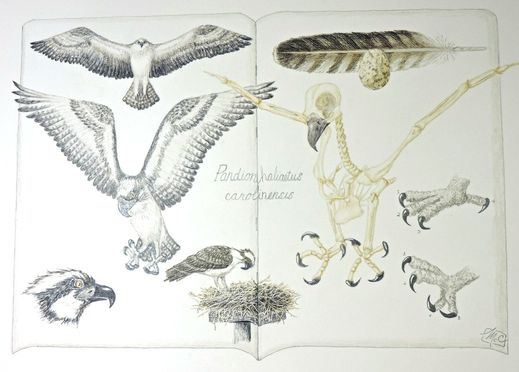
- Osprey
- 14" X 11"
- Colored pencil, graphite
Another "Drawn on Tradition" series referenced the bird illustrations of Keith Brockie. His work features field journal pages with several studies of the bird's anatomy and habitat. I chose the Northern Osprey because there is a nesting platform near my home where I have watched for many years as a pair return each year to raise 1 to 2 chicks. The Rocky Mountain Raptor Program generously allowed me to use an osprey skeleton, feathers, and egg from their education program as models.
